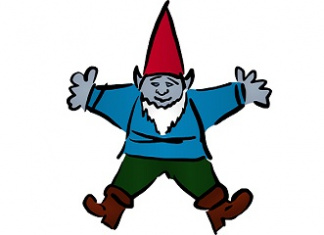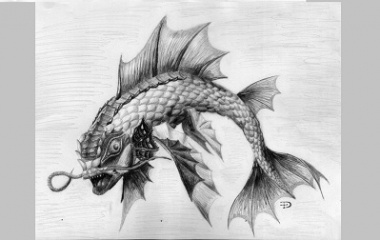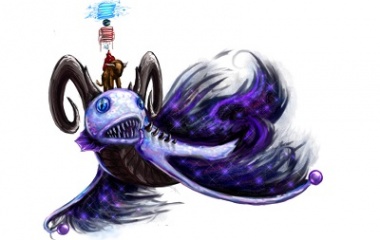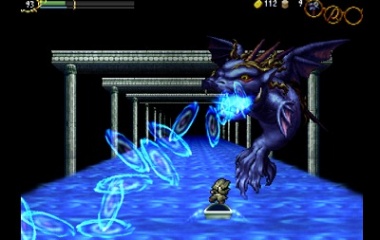Beneath the cosmos, surrounded by water and mist, swims Bahamut, a fish of incomprehensible dimensions who carries the world on his back. No human eye can see Bahamut, but without him, all humans would be plunged into darkness.
What is Bahamut?
Bahamut (also called Behemoth) is a vast fish who serves as the supporter of the world in Arabic cosmography (the study of the cosmos’ organization). Alternatively, in Hebrew mythology, he is the largest land-dwelling creature ever to have been created. He is currently lurking in the underworld, but he will return during the chaos and destruction of the Day of Judgment.
Characteristics
Physical Description
In Arabic mythology, Bahamut is usually described as an unimaginably large fish. To paint a picture of his size, ancient mythology states that,
“all of the waters in the world, placed in one of his nostrils, would be like a mustard seed in a desert.”
Some myths describe Bahamut as having the head of a hippopotamus or an elephant. Occasionally, he is given a more monstrous form, appearing as a sea-serpent with limbs and fierce teeth.
Hebrew texts abandon Bahamut’s fish form altogether, and describe him as an enormous, river-dwelling creature with “strength in his loins, […] force in the navel of his belly, […] tail like a cedar, and […] bones like bars of iron.”
Special Abilities
Bahamut’s power lies in his massive size and strength. According to Arabic mythology, he supports the “seven stages of the earth,” which may refer to the seven astronomical bodies visible to the naked eye—Mercury, Venus, Mars, Jupiter, Saturn, the Sun, and the Moon—or to some division of the heavens above the Earth.
On his back, Bahamut carries a bull, named Kujata. On Kujata’s back, there is a mountain made of ruby. On top of the ruby mountain, an angel holds the seven stages of the earth. Alternatively, a beach of sand lies on Bahamut’s back. Kujata is standing on the sand, and a rock on his back contains the waters in which the earth is floating. Beneath Bahamut is a dark, mysterious realm of swirling mist or water. Some accounts claim that, beneath the dark realm, there is a fiery world inhabited by a snake named Falak.
In addition to his brute strength, Bahamut also has the ability to baffle human vision. He is so large that even the mere sight of him would drive a man out of his senses.
A variation of Bahamut appears in Hebrew legend, under the name Behemoth. Behemoth usually takes the form of a hippopotamus, elephant, or bull. He dwells on land and is famous for his huge appetite. He is sometimes cast as a servant of Satan and said to preside over gluttonous banquets in Hell.
The terrible roar of the Hebrew Behemoth takes on special powers during the summer solstice. With one roar, the mighty Behemoth tames all of the wild predators on Earth, so that they are less ferocious during the rest of the year.
Weaknesses
The Bahamut of Arabic mythology has no known weaknesses, although he must answer to the commands of his creator. It’s possible that he could be consumed by Falak, the snake of the fiery underworld, if Falak wasn’t restrained by fear of that same creator.
The Hebrew Behemoth is less invincible. He too must obey his creator. On the Day of Judgment, he will be sentenced to battle Leviathan, a sea monster who God created as his counterpart. Both monsters will eventually be killed by their creator and served to worthy humans at a banquet that follows the Day of Judgment.
Related Creatures
Bahamut interacts with a variety of other mythological creatures. The most notable among them are Kujata, the bull who stands on top of his head; Falak, the snake who lives in the underworld beneath him; and Leviathan, the sea-creature with which he is to do battle on the Hebrew Day of Judgment.
Although Bahamut interacts with his fellow creatures, there are no other creatures in Arabic or Hebrew mythology that share his characteristics. According to Hebrew legend, Bahamut was purposefully made one-of-a-kind because his appetite was so big that his creator didn’t want him to reproduce; his offspring would have eaten the whole world.
Cultural Representation
Origin
Bahamut probably made his first appearance in Arabic cosmography. He appears in tomes of cosmography that date back as far as 1291. From there, his character was rapidly assimilated into Hebrew culture, but by the time he appeared in Hebrew writings, he had undergone a number of important transformations.
The word “Bahamut” in Arabic means “beast.” Bahamut was probably given this name because of his size and because he is sometimes given fearsome attributes, like sharp teeth and claws. “Behemoth” is the Hebrew translation of “Bahamut.”
Literature
Bahamut appears in many records of Arabic cosmography, most notably, in the works of the ancient Arabic historian, Ibn al-Wardi. The most famous references to Bahamut, however, appear in One Thousand and One Nights and in the Bible.
In One Thousand and One Nights, Bahamut is glimpsed by a man named Isa. Horror-stricken by Bahamut’s size, Isa loses consciousness. When he awakes, Allah (God) asks him if he has seen the enormous fish. Isa replies that he has only seen the bull on the fish’s head and that it was the length of three days’ journey. Allah then impresses Isa with the fact that he creates 40 fishes like Bahamut every day.
In the Bible, Bahamut (referred to as Behemoth) is described in the book of Job. The passage primarily focuses on the incredible might of Behemoth, as a way of glorifying God, who is able to create and control such an awesome creature.
Some Jewish writings, including the Book of Enoch and the Haggadah, expand upon Behemoth’s lore by describing the battle that will be waged between him and Leviathan on the Day of Judgment.
Visual Arts
Sci-fi movies, stretching all the way from the 1950s to the present day, have spotlighted the monstrosity of Bahamut (Behemoth). Few of them stay true to early mythological descriptions of Bahamut, but the creatures who take Bahamut’s name are always portrayed as gigantic.
Perhaps Bahamut’s biggest impact on modern culture is his role in the Final Fantasy video game series. Bahamut appears as a dragon capable of wielding deadly amounts of energy as a weapon. He is often the final and most dangerous villain who players face in the game.
Explanations of the Myth
While Bahamut himself is certainly larger than life, several real animals have been put forward as prototypes for “the beast.”
The passage in the Book of Job, which gives a lengthy physical description of “Behemoth,” has been scrutinized by zoologists for decades in the hope of determining which animal might have inspired the Behemoth legend. Most agree that Behemoth is probably based on a hippopotamus because he is described as feeding on grass like an ox, and lying under the lotuses and reeds of a marsh or river.
An alternate explanation of Behemoth has been popularized by young Earth creationists, who believe that the Bible contains a perfectly accurate account of the creation of the world. They claim that Behemoth represents a sauropod dinosaur.










